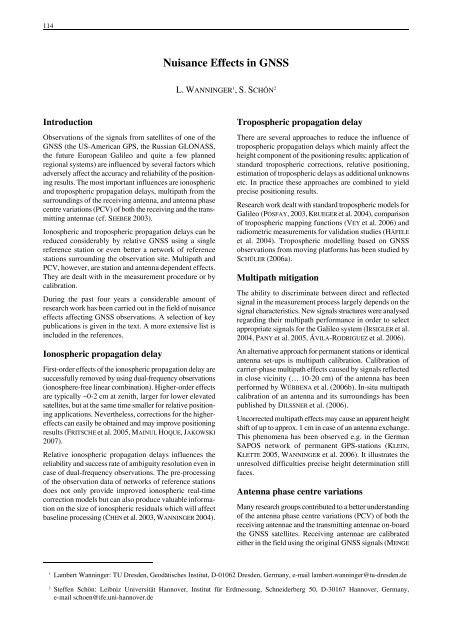NATIONAL REPORT OF THE FEDERAL REPUBLIC OF ... - IAG Office
NATIONAL REPORT OF THE FEDERAL REPUBLIC OF ... - IAG Office
NATIONAL REPORT OF THE FEDERAL REPUBLIC OF ... - IAG Office
Create successful ePaper yourself
Turn your PDF publications into a flip-book with our unique Google optimized e-Paper software.
114<br />
Introduction<br />
Observations of the signals from satellites of one of the<br />
GNSS (the US-American GPS, the Russian GLONASS,<br />
the future European Galileo and quite a few planned<br />
regional systems) are influenced by several factors which<br />
adversely affect the accuracy and reliability of the positioning<br />
results. The most important influences are ionospheric<br />
and tropospheric propagation delays, multipath from the<br />
surroundings of the receiving antenna, and antenna phase<br />
centre variations (PCV) of both the receiving and the transmitting<br />
antennae (cf. SEEBER 2003).<br />
Ionospheric and tropospheric propagation delays can be<br />
reduced considerably by relative GNSS using a single<br />
reference station or even better a network of reference<br />
stations surrounding the observation site. Multipath and<br />
PCV, however, are station and antenna dependent effects.<br />
They are dealt with in the measurement procedure or by<br />
calibration.<br />
During the past four years a considerable amount of<br />
research work has been carried out in the field of nuisance<br />
effects affecting GNSS observations. A selection of key<br />
publications is given in the text. A more extensive list is<br />
included in the references.<br />
Ionospheric propagation delay<br />
First-order effects of the ionospheric propagation delay are<br />
successfully removed by using dual-frequency observations<br />
(ionosphere-free linear combination). Higher-order effects<br />
are typically ~0-2 cm at zenith, larger for lower elevated<br />
satellites, but at the same time smaller for relative positioning<br />
applications. Nevertheless, corrections for the highereffects<br />
can easily be obtained and may improve positioning<br />
results (FRITSCHE et al. 2005, MAINUL HOQUE, JAKOWSKI<br />
2007).<br />
Relative ionospheric propagation delays influences the<br />
reliability and success rate of ambiguity resolution even in<br />
case of dual-frequency observations. The pre-processing<br />
of the observation data of networks of reference stations<br />
does not only provide improved ionospheric real-time<br />
correction models but can also produce valuable information<br />
on the size of ionospheric residuals which will affect<br />
baseline processing (CHEN et al. 2003, WANNINGER 2004).<br />
Nuisance Effects in GNSS<br />
L. WANNINGER 1 , S. SCHÖN 2<br />
Tropospheric propagation delay<br />
There are several approaches to reduce the influence of<br />
tropospheric propagation delays which mainly affect the<br />
height component of the positioning results: application of<br />
standard tropospheric corrections, relative positioning,<br />
estimation of tropospheric delays as additional unknowns<br />
etc. In practice these approaches are combined to yield<br />
precise positioning results.<br />
Research work dealt with standard tropospheric models for<br />
Galileo (PÓSFAY, 2003, KRUEGER et al. 2004), comparison<br />
of tropospheric mapping functions (VEY et al. 2006) and<br />
radiometric measurements for validation studies (HÄFELE<br />
et al. 2004). Tropospheric modelling based on GNSS<br />
observations from moving platforms has been studied by<br />
SCHÜLER (2006a).<br />
Multipath mitigation<br />
The ability to discriminate between direct and reflected<br />
signal in the measurement process largely depends on the<br />
signal characteristics. New signals structures were analysed<br />
regarding their multipath performance in order to select<br />
appropriate signals for the Galileo system (IRSIGLER et al.<br />
2004, PANY et al. 2005, ÁVILA-RODRIGUEZ et al. 2006).<br />
An alternative approach for permanent stations or identical<br />
antenna set-ups is multipath calibration. Calibration of<br />
carrier-phase multipath effects caused by signals reflected<br />
in close vicinity (… 10-20 cm) of the antenna has been<br />
performed by WÜBBENA et al. (2006b). In-situ multipath<br />
calibration of an antenna and its surroundings has been<br />
published by DILSSNER et al. (2006).<br />
Uncorrected multipath effects may cause an apparent height<br />
shift of up to approx. 1 cm in case of an antenna exchange.<br />
This phenomena has been observed e.g. in the German<br />
SAPOS network of permanent GPS-stations (KLEIN,<br />
KLETTE 2005, WANNINGER et al. 2006). It illustrates the<br />
unresolved difficulties precise height determination still<br />
faces.<br />
Antenna phase centre variations<br />
Many research groups contributed to a better understanding<br />
of the antenna phase centre variations (PCV) of both the<br />
receiving antennae and the transmitting antennae on-board<br />
the GNSS satellites. Receiving antennae are calibrated<br />
either in the field using the original GNSS signals (MENGE<br />
1 Lambert Wanninger: TU Dresden, Geodätisches Institut, D-01062 Dresden, Germany, e-mail lambert.wanninger@tu-dresden.de<br />
2 Steffen Schön: Leibniz Universität Hannover, Institut für Erdmessung, Schneiderberg 50, D-30167 Hannover, Germany,<br />
e-mail schoen@ife.uni-hannover.de











